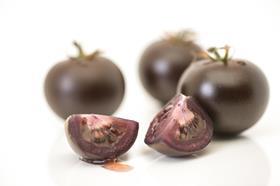
The debate on GM so often centres on ethics that it’s easy to sideline the ongoing and real-life trials in genetically-modified fruit andvegetables.
But behind the slow-moving bureaucracy and the lobbying, and from the safety of confined research institutes, British scientists are spearheading two projects using GM techniques to create benefits to human health, or establish disease resistance.
First up, a genetically-modified purple tomato, created by scientists at the John Innes Centre in Norwich. The tomato has been created by inserting two genes from the snapdragon plant, which are naturally high in a purple compound known as anthocyanin and linked to reduced cardiovascular risk.
The first round of trials, using live animals, recorded a successful reduction in artery clogging through eating the purple tomatoes. Next, researchers will move onto feeding patients who are in high cardiovascular risk categories with soup made from GM tomatoes, using a standard red tomato soup as a control.
With a strong belief that we should be able to obtain health benefits through any safe means possible, Cathie Martin, group leader at the John Innes Centre, believes developing countries that are becoming more urbanised would most benefit from the GM tomato, to counter diets that typically become full of fats or sugars.
“At the moment, because it is GM technology, all we can do is get a product out in the US, so that’s what we plan to do. We’ve also had a pilot trial in Canada, which had a bumper yield,” she explains. “The tomatoes will only be grown in confinement, using insect-free glasshouses. Otherwise there is other legislation to meet.”
Following approval from the Food and Drugs Administration (FDA) in the US, and time taken to bulk up seed supply, Martin says the first tomatoes may be available within two years.
The same health benefits could be created by editing tomato genes, says Martin, rather than inserting genes from other plants, in a non-GM process known as genome editing – although this is much more complex.
“Marketing fruit and vegetables as low in anthocyanin is outrageous – even if you’re anti-GM, eat more purple broccoli, purple berries or aubergines,” she adds.
Although there are some purple tomatoes stocked in Waitrose, Martin says these are a naturally-occurring colour mutation and only have low levels of anthocyanin in the skin, whereas GM purple tomatoes would have health benefits embedded in their DNA, marketable to a health-conscious western consumer as well as nutritionally beneficial to developing countries.
From health benefits to disease resistance, and scientists at the Sainsbury Laboratory have secured funding to develop a Maris Piper potato with resistance to late potato blight and potato cyst nematodes.
The TSL Potato Partnership Project will take place over five years in a confined area near Norwich. It has the backing of the Horticulture and Potato Initiative (HAPI), as well as other scientific funding bodies and two commercial partners – BioPotatoes UK and US-based Simplot. If successful, both companies say they will go for regulatory approval in the US and Europe.
“We’re still some years away from our final crop. It would need to go through all the necessary approval processes,” says project leader Jonathan Jones. “If it passes those tests and if it is approved for planting, this potato could prevent many tonnes of pesticides and fungicides being sprayed on our land, increase yields and make a healthier crisp or chip.”
Best of the rest
• Feb 2015, US - The world’s first GM apples were greenlighted to be grown commercially in the US following a decision to approve two non-browning versions of Golden Delicious and Granny Smith for large-scale planting. The apples were developed by Canadian group Okanagan Specialty Fruits (OSF) and could be on the market in 2016.
• June 2014, Australia - The first human trial of GM bananas enriched with beta-carotene, which converts to vitamin A in the body, was announced in 2014. Dubbed the ‘super banana’, the project aims to prevent children in East Africa from going blind from severe vitamin A deficiencies. It was developed by Australia’s Queensland University of Technology (QUT), with trials set to take place in the US.
• 2010-2014, Bangladesh - The Monsanto-developed GM aubergine, known as Bt Brinjal, has a gene that repels borer pests, although there have been mixed reports about its efficacy. The anti-GM lobby claims public health studies were repressed, while the biotech industry refutes “unsubstantiated information” that has affected sales.



